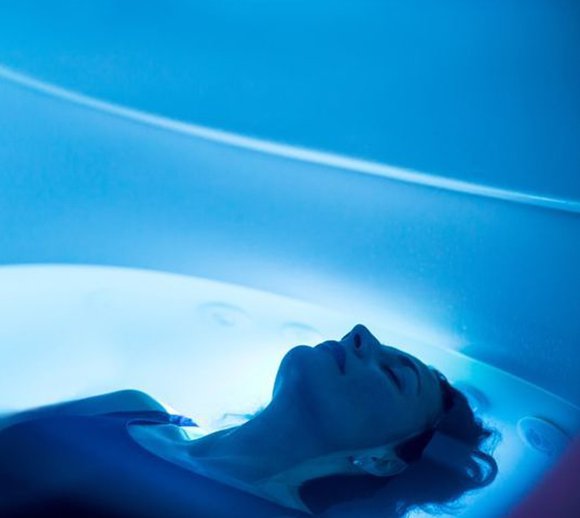First time visitor? Pick $100 towards treatment of your choice in Solea MedSpa or pick the Promo

Floatation Therapy Sunny Isles Florida
What is Floatation Therapy?
Floatation therapy is the practice of floating inside a darkened, quiet tank filled with warm water and magnesium sulfate (epsom salts). In a float tank — also called a sensory deprivation tank — you are cut off from virtually all external stimuli, which allows you to focus completely on the experience of being in your body. Many people find this helps them achieve a state of deep relaxation, supporting their mental, emotional, and physical wellness.
Float therapy is a powerful tool to relax and de-stress, as well as increase creativity. Many people who try float therapy find the experience restful, rejuvenating and even profound. Because virtually any health condition is made worse by stress, float therapy can be a useful treatment for a wide range of health issues. Studies have found that float therapy can reduce stress, depression, anxiety, and pain while increasing optimism and quality of sleep. Float therapy is often used to promote overall wellness.
Other names for float therapy include sensory deprivation therapy, isolation therapy, floatation therapy or restricted environmental stimulation therapy (REST).


How does float therapy work?
Float therapy helps you to achieve feelings of calm and deep relaxation by cutting you off from almost all external stimuli, including light, sound, and touch. The containers in which float therapy sessions take place are designed to isolate you completely from the outside world.
Method
Float tanks are sealed, light- and soundproof tanks that are partially filled with epsom-salt infused water. The water is heated to the same temperature as your skin, which makes it difficult to feel any separation between your body and the water itself. Because of the epsom salts in the water, you float effortlessly on your back, without any danger of turning over or drowning.
During a float session, you typically spend 45 to 90 minutes inside the tank. There should be enough room in the tank to stretch out comfortably. If you are afraid of being in a small, dark enclosed space (a common fear), the tank can be left open, although most people find that they feel comfortable enough to close the tank after a few minutes.
What are the benefits of sensory deprivation and float therapy?
Physical benefits of float therapy
The physical benefits of float therapy can include a major reduction in the body’s production of stress hormones, including cortisol and adrenaline. When excess stress hormones are produced, the body becomes distressed and problems such as stress-induced chronic pain, high blood pressure, endocrine system disturbances, and gastrointestinal issues arise. In other words, floating can help with any health condition exacerbated or caused by stress, including:
- Chronic pain
- Fibromyalgia
- Hypertension
- Rheumatoid arthritis
- Insomnia
- Inflammation
- High blood pressure
- Slowed recovery from injury
- Migraines
- Circulation problems
The epsom salts in a float tank also treat magnesium deficiency. Epsom salts are a form of magnesium, a mineral essential to human health. However, many people don’t get enough magnesium through diet alone—indeed, magnesium deficiency is a common health concern. In a float session, your body absorbs magnesium through the skin, which helps to correct any magnesium deficiency.


Mental benefits of float therapy
The vast majority of people who experience a float session describe increased feelings of calm and well-being. Floaters also often find that they feel a sense of increased clarity and alertness, as well as a heightened sense of creativity, capacity to visualize, awareness and ability to meditate. Float therapy is recognized as a particularly effective treatment for the effects of stress on the mind as well as the body.
Emotional benefits of float therapy
If you are struggling with anxiety or depression, as well as more generalized emotional pain, a float session can be a useful way to feel more at ease in your own body. Because float therapy activates your body’s calming parasympathetic nervous system, it can bring you out of the heightened state of anxiety commonly known as fight, flight or freeze. Because there is nothing going on around you other than the nurturing sensation of floating in warm water, your body feels secure enough to relax and let go. This can help you process your emotions in a safe, comfortable space.
Are float tanks sanitary?
The interior of a float tank is exceptionally sanitary. Each tank has up to 1,500 pounds of Epsom salt dissolved in the water, which raises the salinity to levels that are inhospitable to bacteria, including microbes and other pathogens.
The Solution is sterilized between each session through a process of commercial-grade circulation, filtration and purification using a combination of UV (Ultraviolet Light) and Ozone. No harsh chemicals (Chlorine, Bromine etc) are used in the solution at our facilities.
Is there anyone who should not use a float tank?
Float tanks are not recommended for some people. Anyone with one or more of the following conditions should not use float tanks: uncontrolled epilepsy, drug or alcohol intoxication, infectious disease, open wounds and serious psychological conditions.
Is one float enough, or do I need multiple sessions?
Much like exercise, meditation or therapy, floating is a practice. It is common to have a pleasant and relaxing experience during your first float, and you can expect to find that the experience strengthens and lengthens each time. You may only realize the full therapeutic potential of floating after multiple sessions. Many people find that floating 1-2 times a week allows them to sustain the benefits of floating.
†Individual results and experience may vary.
-

Solea Medical Spa and Beauty Lounge your first and final destination for all your beauty and medical needs.
305-912-2155
info@soleabeautylounge.com
18140 Collins Ave, Sunny Isles Beach, FL, 33160, United States
- Body Treatments
- Health And Wellness Treatments
- Medical Treatments
- Facial Treatments
